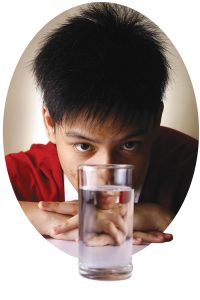Open for Discussion: Lead in Your Water: Is Any Amount Safe?
By Adrian Dingle December 2016

The recent lead contamination problem in Flint, Mich., was not the first time there has been a severe public health issue caused by a tainted water supply. As recently as February 2016, officials in Ithaca, N.Y., distributed bottled water to children after lead levels that were hundreds of times higher than recommended were detected in drinking water in a local school. Similar cases have come to light in Portland, Ore., Newark, N.J., and in Baltimore, Md.
As in Flint, many of the problems in these other cases were due to the corrosion of pipes that carried water to people’s homes, and, as in Flint, among the main culprits were copper and lead. But the water we drink everyday already contains small amounts of lead and copper (along with other metals), so how do we know when their amounts are too high to make water unsafe to drink?
The Lead and Copper Rule
In the United States, the Environmental Protection Agency (EPA), which is the governing body that oversees the protection of the environment, enforces regulations that are meant to keep water safe. One of them is the Lead and Copper Rule (LCR). Although the rule is relatively simple, what is less clear is whether it is really effective in protecting consumers.
The LCR states the following: After testing water taken from the taps of consumers, if more than 10% of the samples exceed 0.015 milligrams per liter (mg/L) for lead or 1.3 mg/L for copper, then further steps must be taken. But when these levels are exceeded, a complete shutdown of the water supply is not required. The question then becomes, is the action that is mandated when these levels are exceeded enough? Is letting the public know about the problem, requiring additional water treatment by the supplier, and advising people about how to avoid problems sufficient to keep consumers safe? These are some of the questions that some people have been grappling with, and you may want to consider them, as well.
Tiny numbers
What does 0.015 mg/L really mean? Because 1 L of water has a mass of 1,000 g or 1 million milligrams, then 1 mg of a contaminant in 1 L of water is equivalent to 1 part per million (ppm). Because 0.015 mg/L is 1,000 times smaller than 15 mg/L, then 0.015 mg/L is equal to 15 parts per billion (ppb). To give you an idea of how small that amount is, 15 ppb is equivalent to approximately 45 seconds in a whole century!
The World Health Organization (WHO) says, “There is no known level of lead exposure that is considered safe.” In addition, the action level for lead was never based on any medical research; rather it was what water suppliers considered to be a manageable number when the LCR was issued in 1991.
Investigating further
Sometimes, the WHO and EPA recommendations vary (as is the case with lead), but in other cases, there is more agreement. For example, in the case of arsenic, 0.010 mg/L (10 ppb) is considered an acceptable level by both organizations.
So what can you do? Ask the company that supplies your drinking water for its annual water quality report. It will list all kinds of chemicals that are found in your water supply, along with their concentrations. Then, find out if some of these chemicals exceed the WHO or EPA recommendations. The number of chemicals that are in drinking water might surprise you and, hopefully, they will all be below the levels recommended by WHO or EPA.

